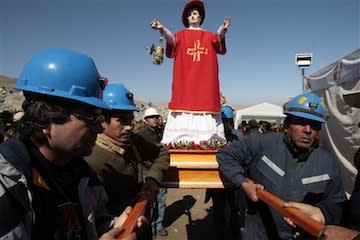 The Upshot
The UpshotChile struggles to keep up morale of trapped miners

A team of four NASA employees arrived in Chile on Wednesday to help the government deal with the 33 miners who experts say will be trapped 2,300 feet below the surface for at least another three months.
Chilean President Sebastian Pinera has repeatedly stressed that he's determined to ensure the rescue of the men -- who miraculously survived when the mine collapsed Aug. 5 -- no matter the cost. But there are numerous logistical challenges in sustaining the trapped crew as its members await rescue, such as simulations of day and nighttime lighting as well as preserving their strength. And the Chilean authorities have made some miscues in their efforts to orchestrate a subterranean routine.
Recently, for example, an official announced that five of the miners suffered from depression. The next day, he announced they'd been "cured."
"That is probably not such a good idea," Lawrence Palinkas, a University of Southern California professor of social policy, told the Guardian. "These diagnoses carry a certain stigma … and the miners have no control over the conditions which caused this — which makes it all the more important that the government protect confidentiality."
[33 men. 600 square feet. 90-degree stagnant air: The harrowing ordeal facing miners]
More troubling, perhaps, is the government's decision to censor the letters from loved ones that rescue workers are dropping down to the miners in an effort to maintain morale, the Guardian reports. Government psychologists are helping the loved ones craft the letters to avoid upsetting the miners; the British paper also reports that newspaper dispatches sent to the miners are likewise being censored to omit upsetting content.
[True tales of surviving entrapment without going crazy]
It's debatable whether such measures are a necessary precaution -- experts told the Guardian that they aren't called for, since the miners themselves know all too well that their situation is potentially dire. Still, it's quite clear why government officials are worried the situation could turn volatile. In addition to dealing with the trauma of being trapped thousands of feet below the surface, some of the miners are alcoholics and are now exhibiting symptoms of withdrawal, the Telegraph reports. (A Chilean health official denies this).
[For one miner's family, unbelievable misfortune]
James Michael Duncan, a NASA doctor who just arrived to help the miners, denied the group's request that wine and cigarettes be sent down with their supplies. They will receive nicotine patches instead.
[What's the space agency got to do with a mining disaster? | Astronauts' advice for miners]
"These miners showed us tremendous strength in surviving as long as they did without any contact with the surface," he told the paper. "What we want to try to avoid is any kind of situation of hopelessness on the part of the miners."
On Wednesday, miners had their first hot meal -- meatballs and rice -- since becoming trapped. Now the focus is on giving them a sense of routine as they await their long rescue.
Click image to see slideshow of the Chilean miners' ordeal
Video frame grab via Reuters
"The most important thing we're doing right now from the psychological point of view is to simulate conditions of day, night, and separating the space where they're living into zones," Health Minister Jaime Manalich told Agence France Press.
LED lights will be set up to simulate day and night, and a strict eating and sleeping schedule will be put in place.
There's a practical as well as psychological reason that the miners will need a normal, structured routine during their captivity: They'll need all their strength to help with the rescue.
[LiveScience: The technologies that will save the miners]
They will have to move 3,000 tons of rock on around-the-clock shifts for months, reports Sky News: After about a month of drilling, rock will begin to fall where the miners are, and they will have to constantly clear the rock if they don't want to become trapped again.
Meanwhile, the company that owns the mine says it may go bankrupt, meaning the trapped miners would not be paid while awaiting rescue, since the Chilean government has said it can't pay the wages.
(Photo of Chilean miners carrying an effigy of the patron saint of miners, Saint Lorenzo: AP)
Other popular Yahoo! stories:
• Why owning a home is still a smart move
• How to make restaurant-quality burgers
• Paris Hilton faces Vegas hotel ban after scandal | Photo: See her mugshot

